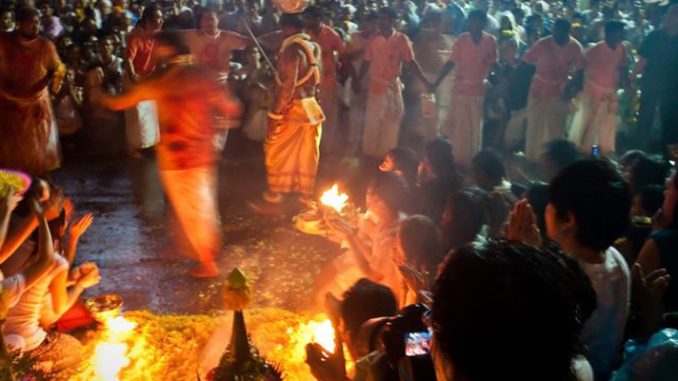
In recent decades Thai Buddhists increasingly have turned to Hindu deities as benevolent sources of miraculous assistance and devotional intimacy.
Within contemporary Bangkok there are many public sites fueling curiosity in Hindu deities and devotional practices, if not Hinduism itself. There are Hindu temples originally founded by Indian migrants to serve diasporic communities, such as the Sri Mahamariamman temple (Wat Khaek), the Dev Mandir, the Durga Mandir, and the Vishnu temple (Wat Wisanu). There are temples constructed by ethnic Thai Buddhists to pay devotion to Hindu deities, such as the Devasathan (Bot Phram) built for court Brahmins at the beginning of the Chakri dynasty or the large Siva temple on Ramindra road built in the more recent past. There is also an expanding landscape of stand-alone public shrines centered on statues of Hindu deities and built by various individuals, private institutions or governmental organizations. The Brahma statue at the Erawan shrine is perhaps the most famous example of this, even as other shrines to Indra, Narayana, Laksmi, Trimurti and Ganesh are also now located within close walking distance from the Ratchaprasong intersection. Finally, statues and shrines to various Hindu deities can easily be found within both Buddhist monasteries (wat) and pan-sectarian sanctuaries for deity worship (thewasathan) throughout the Bangkok metropolis.
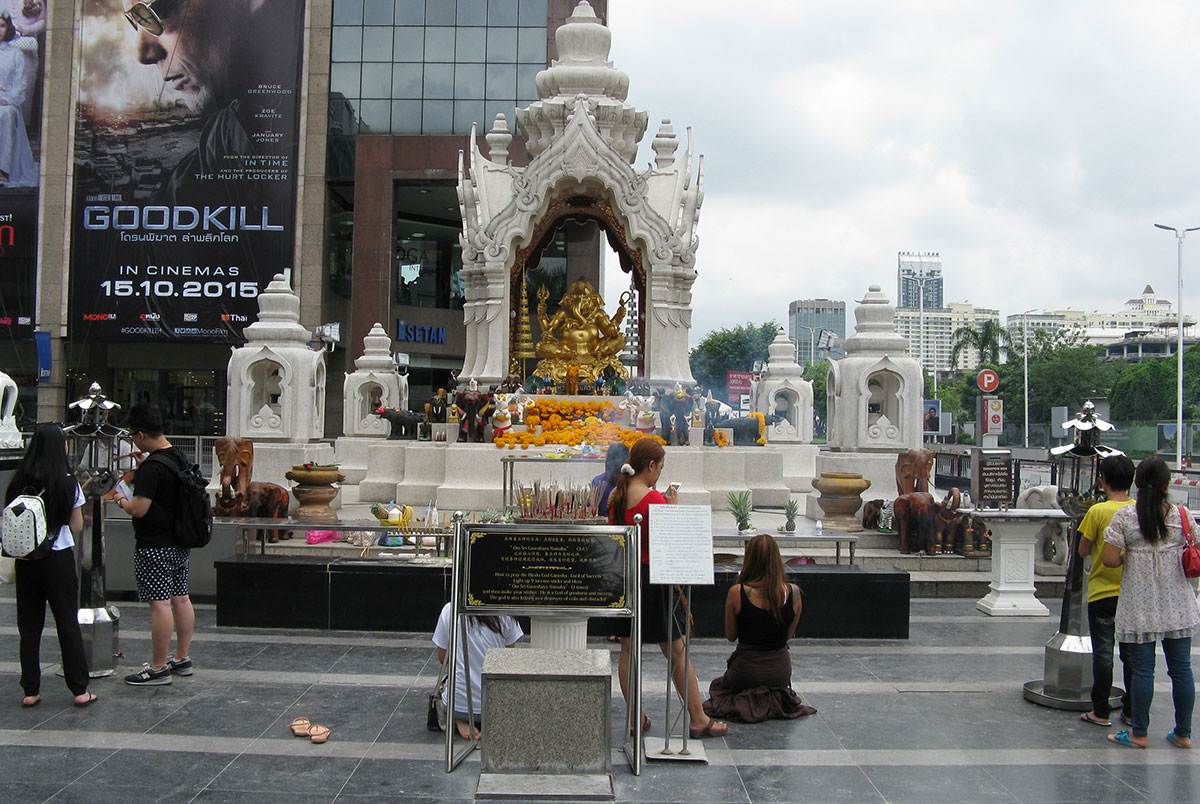
As public venues for either performing Hindu devotion by ethnic Indians or displaying devotion to Hindu deities by Thai Buddhists, these places of worship serve as crucial foci in the collective social reproduction and public imagining of Hinduism for both ethnic Thais and Indians in Bangkok. When Hindu temples (or the Ramindra Siva temple in association with Hindu organizations) organize and promote Hindu ceremonies as large scale public festivals, however, the religious worlds, ritual imaginations and devotional logics of Indian Hindus and Thai Buddhists almost inevitably become inextricably intertwined. Joined together – both by design and by accident – in the collaborative work of producing iconic ceremonies within the Hindu ritual cycle, what emerges are not only defining moments of conventional Hindu religiosity for the Indian community but inclusive, non-sectarian spectacles of religious devotion and alterity for the general Thai Buddhist public as well. Through these religious encounters, Buddhist and Hindu actors, communities, and authorities fundamentally become mutually constitutive of each other, raising interesting questions about religious pluralism, inclusion, tolerance and identity within an increasingly urbanized and cosmopolitan Thai social imaginary.
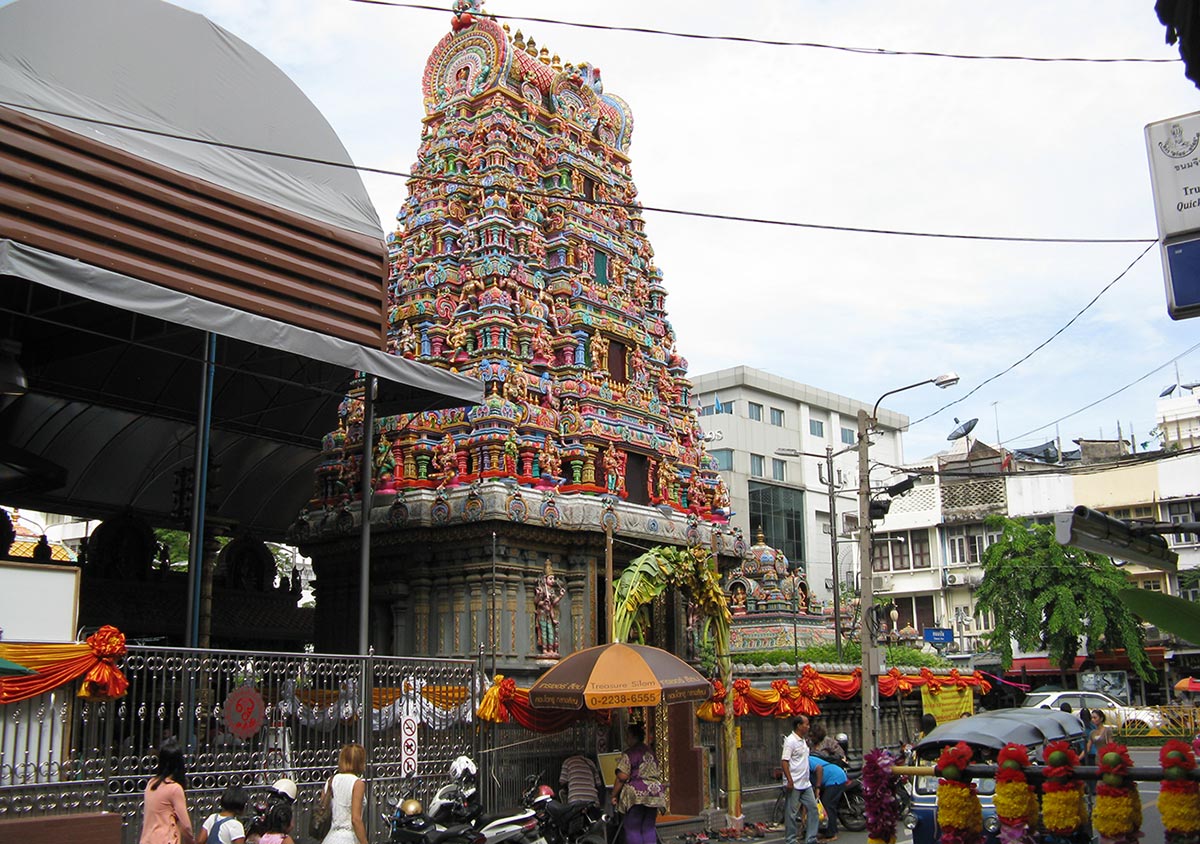
The Navaratri Festival
The ten-day Navaratri festival celebrated each October at the Tamil Sri Mahamariamman temple on Silom road clearly exemplifies the complicated religious entanglements that arise when Hindu ceremonial spectacle is planned, managed and staged on a grand scale in the urban Thai public sphere both by and for plural sectarian communities. 1 Over the course of the multi-faceted festival a progression of female goddesses – Durga, Laksmi, Umathewi, Saraswati – are invited down into the temple and worshipped along with their consorts and attendants. Each day is organized around the coordinated management of 1) a constant stream of conventional sacrificial offerings made by individual members of the general public and 2) a trio of special morning, afternoon and evening sacrificial offerings made by the temple’s Brahmins. The public procession outside the temple on the final evening is the ritual and performative climax of the festival. The core of the procession consists of three Indian spirit mediums possessed by different goddesses and five chariots carrying statues of Ganaphathi, Subramanian, Krishna, Kataragama and Umathewi. Numerous troupes of musicians, dancers, Brahmins and devotees surround these mediums and chariots as the procession snakes out from the temple along a 3 kilometer circular route that can take more than seven hours to complete. Tens of thousands of Thai Buddhist devotees set up large, ornate altars on either side of the procession route, waiting sometimes until 2 or 3am to finally receive blessings from all of the mediums, Brahmins and gods successively passing them by.
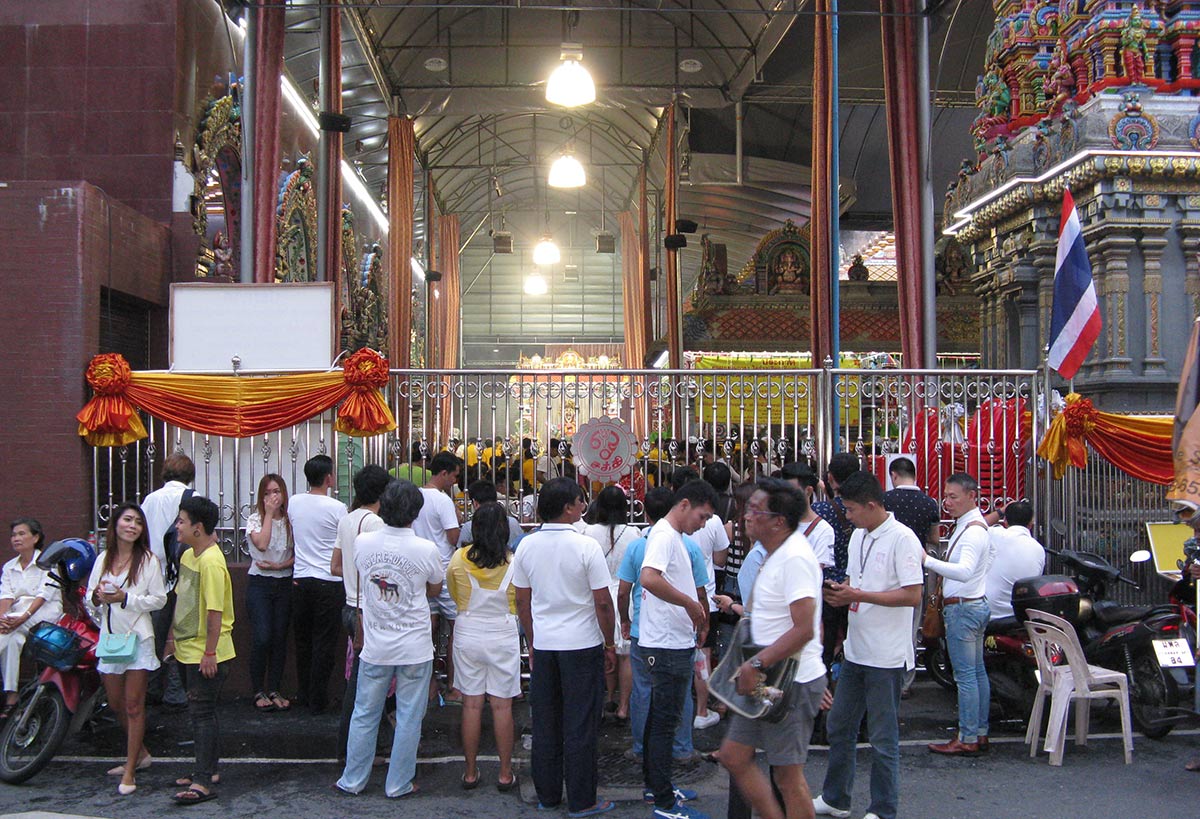
During the first nine days of the festival upwards of 90% of the participating public are ethnic Thai and Sino-Thai Buddhists, while on the closing night as the number of participants from greater Bangkok and upcountry provinces swells astronomically the percentage of ethnic Indian Hindus shrinks even further. Sri Mahamariamman’s Navaratri festival is then, in essence, a central annual ritual event within Bangkok’s Tamil Hindu community that is presided over and managed by Brahmin ritual experts but in which the majority of its devotees, participants and even patrons are neither Indian nor Hindu. The complex mélange of ritual offerings, sacrifice and devotion on very public display over the course of festival’s ten days, therefore, must resonate as both paradigmatically Hindu and authentically Buddhist. Even more impressively however, the Navaratri festival actually facilitates and fosters a plurality of religious actors, devotional perspectives and ritual scripts from within both the Hindu and Buddhist communities, all of which finds satisfying expression and realization during the festival.
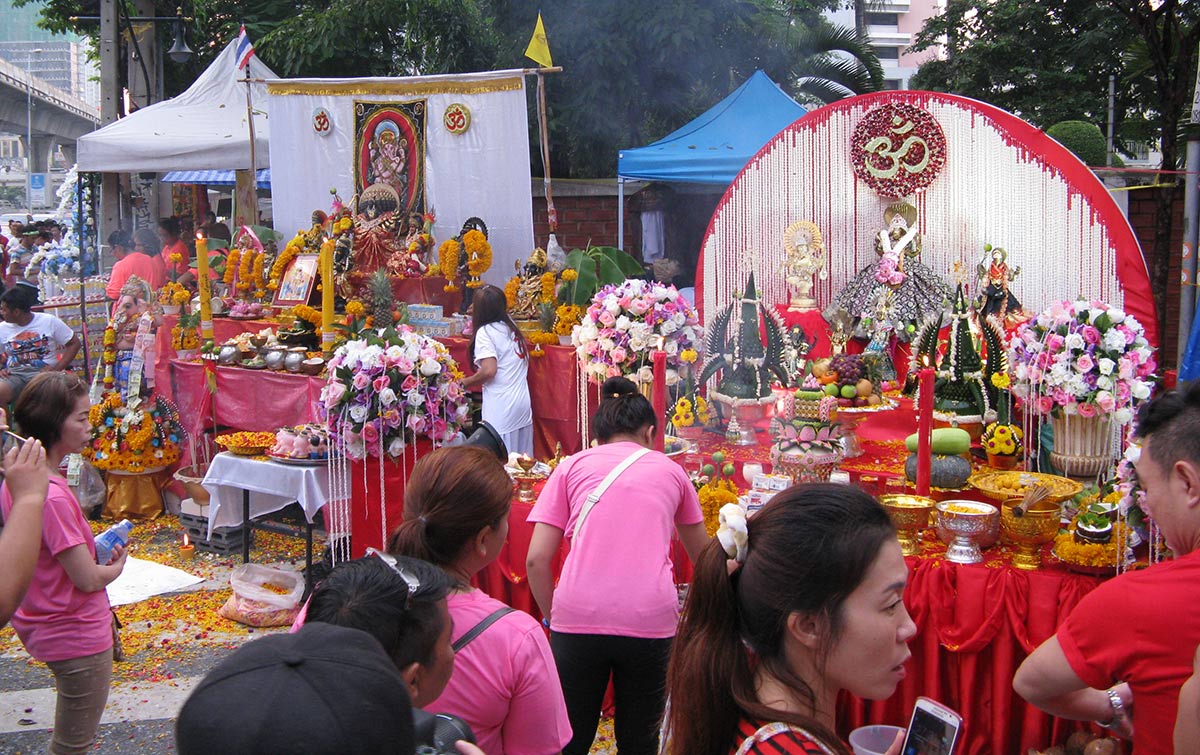
A Plurality of Religious Actors and Ritual Scripts
While ultimately a demographic minority, a diverse assemblage of ethnic Indian Hindus plays a crucial role in staging Navaratri. Brahmin priests, Indian spirit mediums, ritual assistants and classical musicians are key ritual authorities throughout the ceremony. In addition, temple administrators, financial patrons, journalists, and videographers drawn from Silom’s local Indian community are also regular and often important actors in organizing and managing the daily ceremonial activity that runs from early morning until late evening. And while devoted individuals and families from the local Indian community and its merchants make up the largest segment of the participating Hindus, representatives of the Tamil state religious bureaucracy from India as well as a small number of Malaysian and Singaporean Hindus also make an appearance. While not yet an object of transnational Chinese pilgrimage and tourism like the Chinese vegetarian festival held in Phuket, in a contemporary age of globalized media and transportation the Hindu audience of the Navaratri festival clearly reaches beyond just Bangkok.
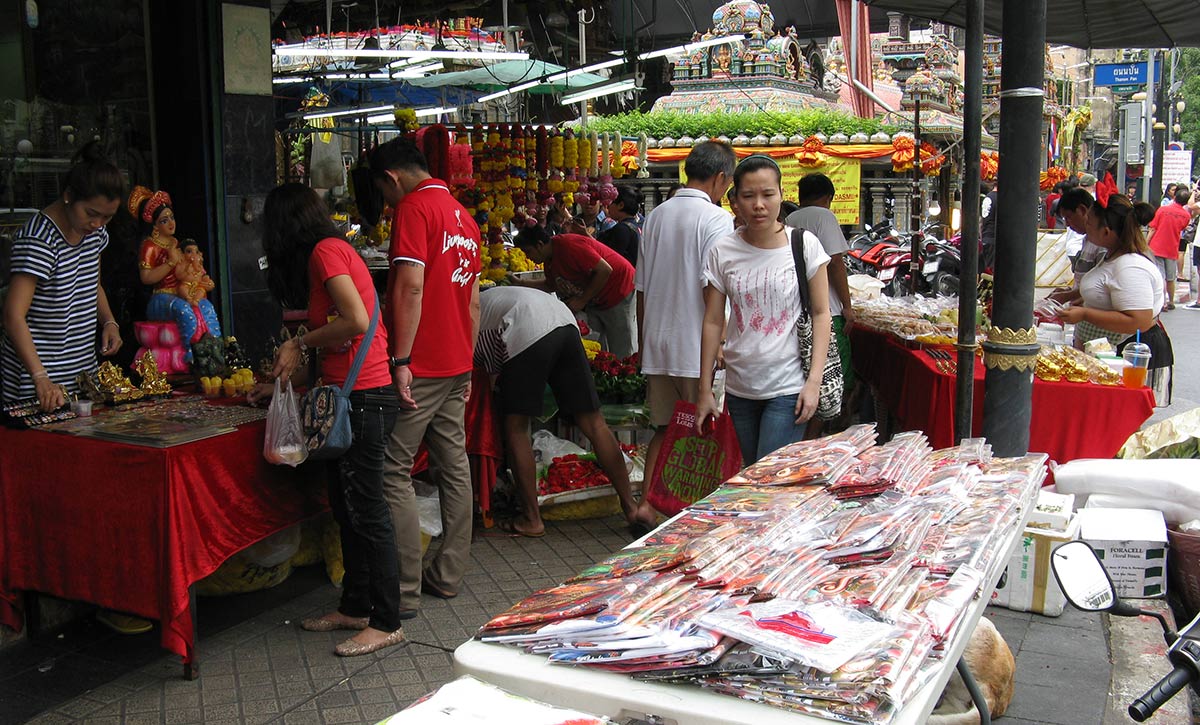
A diverse collection of Thai Buddhist also takes part in the festival. For example, there is a small number of ethnic Thai police and military providing security, street vendors selling ritual supplies, and media figures reporting on the event. More significantly, a large number of local Thai and Sino-Thai Buddhists occupy important positions of authority within the daily life of the Sri Mahamariamman temple. They serve as temple administrators, financial patrons and ritual assistants. A large number of the temple’s ritual assistants are Thai Buddhists, and they are crucial to managing the large volume of supplicants drawn from the general Thai Buddhist public who surge into and through the temple during the festival. These Thai Buddhist visitors, primarily from Bangkok, consist of several distinct constituencies. The vast majority are individuals, couples and families with little enduring commitment to the temple or Hindu deities, but who see the festival as an ideal, one-off chance to gain divine assistance and a blessing. There are a range of Thai Buddhists, however, who return regularly to the temple over the course of the festival and linger to participate in the thrice daily festival ceremonies. Some feel indebted because of spiritual assistance they have received as a result of prior vows and offerings at the temple. Some have developed a special devotional attraction to Hindu deities in general, and the Navaratri festival serves as an ideal occasion for enacting and strengthening this devotion. And some are professional spirit mediums who deeply identify with the Hindu gods and goddesses that regularly possess them and to whom they are karmically indebted as worldly servants.
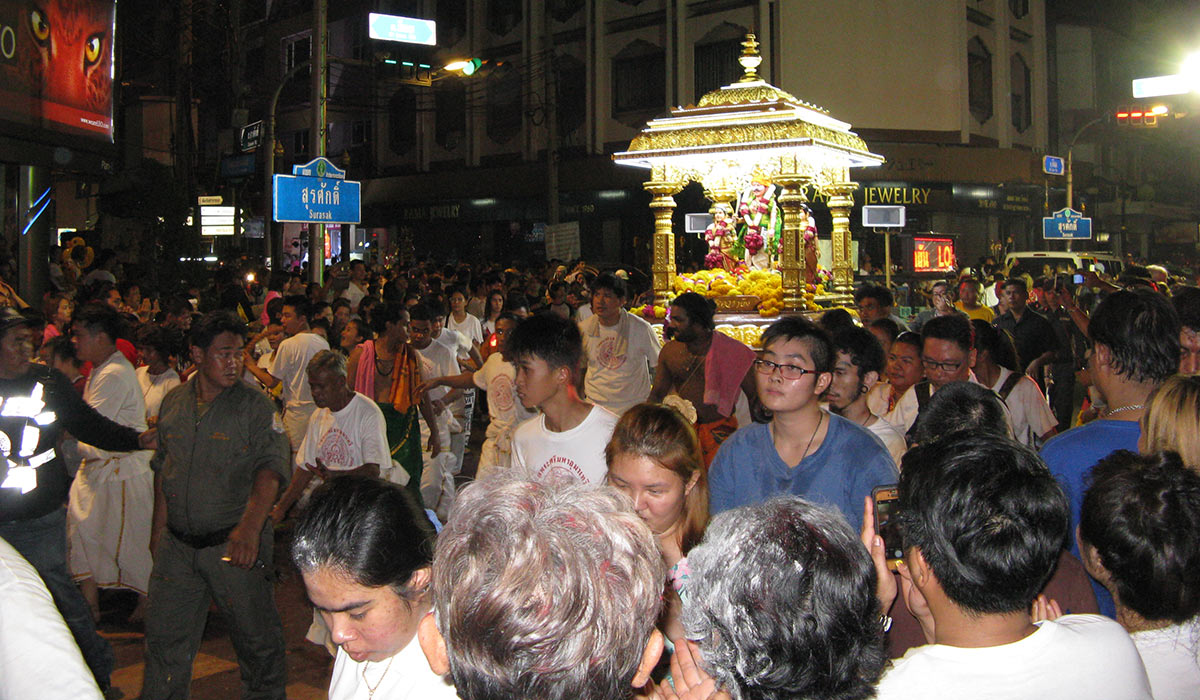
On the final evening of the public procession, these Thai Buddhist constituencies expand in size and character. Large numbers of police, volunteers and vendors arrive to manage and serve the large crowds. Tens of thousands of Thai Buddhists living in the Bangkok metropolitan region who are interested in opportunistically seeking out divine assistance come to witness the procession. The vast majority of those individuals and groups setting up temporary altars along the procession route, however, are either small groups of devotees of Hindu gods or professional spirit mediums assisted by their personal entourages. 2 Almost all of these devotees and spirit mediums have not participated in any rituals previously held at the Sri Mahamariamman temple during the festival, and some travel from as far away as Phitsanulok and Khon Kaen. For the general Thai Buddhist public, these temporary altars along the procession route – with their secondary, subsidiary cycles of ritual offerings and ceremonial spectacle – often become central objects of religious curiosity and engagement, especially since the crush of huge crowds makes access to the temple difficult. Both before and after the procession proper, members of the general public seek out divine blessings, intercession and advice from the various spirit mediums that proliferate in front of altars. The procession route of the festival, in effect, becomes a secondary, autonomous staging site for a raucous Thai Buddhist devotionalism spontaneously organizing itself beyond the direct reach and control of the temple’s Brahman authorities. In fact, it is clear that the social possibilities opened up by a large-scale public spectacle of Buddhist devotionalism, trance possession, performative excess and exotic religiosity which is implicitly sanctioned by orthodox Hinduism is precisely what so many visitors and participants find appealing about the dramatic ending of the Navaratri festival.
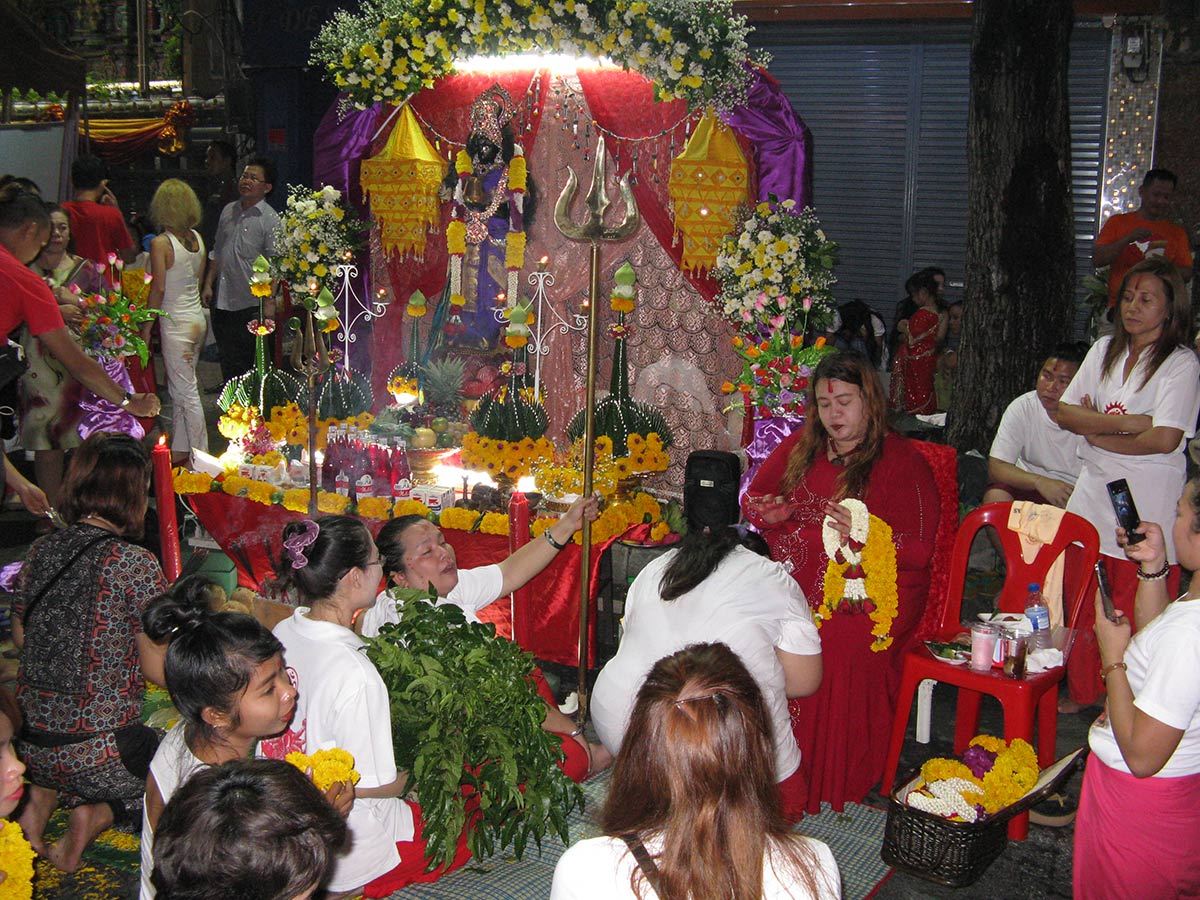
Pluralism, Inclusion and Tolerance in a Buddhist Metropolis
The inextricably intertwined roles of Bangkok’s Hindu and Buddhist communities in staging Sri Mahamariamman’s Navaratri festival are grounded, in part, in a series of large-scale social developments in modern Thailand. The Internet, national mass media markets and global tourism have made Hindu beliefs and practices, in both India and Thailand, more visible, understandable, and accessible to Thai Buddhists. Thai capitalist entrepreneurs have created a niche market in the aesthetic, material and literary cultures of Hindu religiosity. Urbanization and improved transportation networks have made sustained religious encounters between Buddhists and Hindus a mundane possibility for more and more Thais. A diverse field of unregulated religious entrepreneurs engaging in creative spiritual bricolage have served as cultural brokers between the two religious communities. And an expanding, nonsectarian popular religiosity emphasizing miracles, devotionalism, esotericism and ecstasy has fueled religious cross-pollination beyond the control of establishment and orthodox elites. Yet these developments also raise new questions.
Sri Mahamariamman’s Navaratri festival is clearly a Hindu ritual, but can it also now be called a Buddhist ceremony? How does one employ sectarian labels when the dominant mythology and ritual script of a ceremony is rooted in one religious community yet the overwhelming number of participants are drawn from another? Should one treat the ritual cycles of the festival occurring within the temple during the first nine days of the festival as descriptively and analytically distinct from the closing day of the procession when the ritual ethos, devotional logics and religious authorities at play multiply and fragment? In what sense, if any, is the festival an example of syncretism, hybridity, bricolage or transculturation?
Moreover, how does one explain the differential social reality of religious pluralism, inclusion and tolerance in contemporary Buddhist Thailand? While examples of ritual co-participation and cross-pollination abound between Buddhist, Hindu and Chinese religious communities, fewer cases are found between Buddhist, Christian and Muslim communities. To what degree are these differences in cross-sectarian communal relations a result of contrasting patterns in religious demographics, strategies of religious localization, demands for religious purification, historical memories of religious coexistence, and xenophobic fears of religious conversion and conflict? Can one expect ritual co-participation and cross-pollination to serve equally well in bridging sectarian divides between Buddhists and all religious minorities within Thailand, or rather must multiple alternative strategies be fostered in the pursuit of enduring inclusive tolerance?
Erick White
(Cornell University)
Issue 19, Kyoto Review of Southeast Asia, March 2016
Notes:
- The empirical details for this discussion are drawn from participant observation in October 2015. ↩
- I counted more than 500 temporary altars along the procession route in 2015. Most constituted aesthetically elaborate, carefully planned religious shrines in their own right that had required large amounts of money, labor and time to design, build and assemble. ↩
